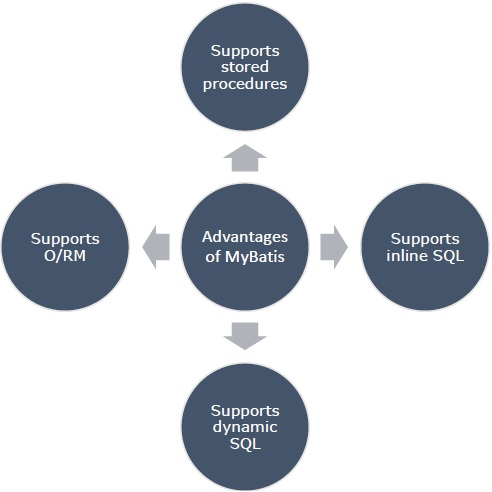mybatis – MyBatis 3 | Mapper XML 文件 http://www.mybatis.org/mybatis-3/zh/sqlmap-xml.html
mybatis – MyBatis 3 | SQL语句构建器 http://www.mybatis.org/mybatis-3/zh/statement-builders.html
Java程序员面对的最痛苦的事情之一就是在Java代码中嵌入SQL语句。这么来做通常是由于SQL语句需要动态来生成-否则可以将它们放到外部文件或者存储过程中。正如你已经看到的那样,MyBatis在它的XML映射特性中有一个强大的动态SQL生成方案。但有时在Java代码内部创建SQL语句也是必要的。此时,MyBatis有另外一个特性可以帮到你,在减少典型的加号,引号,新行,格式化问题和嵌入条件来处理多余的逗号或 AND 连接词之前。事实上,在Java代码中来动态生成SQL代码就是一场噩梦。例如:
// With conditionals (note the final parameters, required for the anonymous inner class to access them)
public String selectPersonLike(final String id, final String firstName, final String lastName) {
return new SQL() {{
SELECT("P.ID, P.USERNAME, P.PASSWORD, P.FIRST_NAME, P.LAST_NAME");
FROM("PERSON P");
if (id != null) {
WHERE("P.ID like #{id}");
}
if (firstName != null) {
WHERE("P.FIRST_NAME like #{firstName}");
}
if (lastName != null) {
WHERE("P.LAST_NAME like #{lastName}");
}
ORDER_BY("P.LAST_NAME");
}}.toString();
}
mybatis – MyBatis 3 | SQL语句构建器 http://www.mybatis.org/mybatis-3/zh/statement-builders.html
工厂方法
从 XML 文件中构建 SqlSessionFactory 的实例非常简单,建议使用类路径下的资源文件进行配置。但是也可以使用任意的输入流(InputStream)实例,包括字符串形式的文件路径或者 file:// 的 URL 形式的文件路径来配置。MyBatis 包含一个名叫 Resources 的工具类,它包含一些实用方法,可使从 classpath 或其他位置加载资源文件更加容易。
String resource = "org/mybatis/example/mybatis-config.xml";
InputStream inputStream = Resources.getResourceAsStream(resource);
SqlSessionFactory sqlSessionFactory = new SqlSessionFactoryBuilder().build(inputStream);
XML 配置文件(configuration XML)中包含了对 MyBatis 系统的核心设置,包含获取数据库连接实例的数据源(DataSource)和决定事务作用域和控制方式的事务管理器(TransactionManager)。XML 配置文件的详细内容后面再探讨,这里先给出一个简单的示例:
<?xml version="1.0" encoding="UTF-8" ?>
<!DOCTYPE configuration
PUBLIC "-//mybatis.org//DTD Config 3.0//EN"
"http://mybatis.org/dtd/mybatis-3-config.dtd">
<configuration>
<environments default="development">
<environment id="development">
<transactionManager type="JDBC"/>
<dataSource type="POOLED">
<property name="driver" value="${driver}"/>
<property name="url" value="${url}"/>
<property name="username" value="${username}"/>
<property name="password" value="${password}"/>
</dataSource>
</environment>
</environments>
<mappers>
<mapper resource="org/mybatis/example/BlogMapper.xml"/>
</mappers>
</configuration>
当然,还有很多可以在XML 文件中进行配置,上面的示例指出的则是最关键的部分。要注意 XML 头部的声明,用来验证 XML 文档正确性。environment 元素体中包含了事务管理和连接池的配置。mappers 元素则是包含一组 mapper 映射器(这些 mapper 的 XML 文件包含了 SQL 代码和映射定义信息)。
不使用 XML 构建 SqlSessionFactory
如果你更愿意直接从 Java 程序而不是 XML 文件中创建 configuration,或者创建你自己的 configuration 构建器,MyBatis 也提供了完整的配置类,提供所有和 XML 文件相同功能的配置项。
DataSource dataSource = BlogDataSourceFactory.getBlogDataSource();
TransactionFactory transactionFactory = new JdbcTransactionFactory();
Environment environment = new Environment("development", transactionFactory, dataSource);
Configuration configuration = new Configuration(environment);
configuration.addMapper(BlogMapper.class);
SqlSessionFactory sqlSessionFactory = new SqlSessionFactoryBuilder().build(configuration);
注意该例中,configuration 添加了一个映射器类(mapper class)。映射器类是 Java 类,它们包含 SQL 映射语句的注解从而避免了 XML 文件的依赖。不过,由于 Java 注解的一些限制加之某些 MyBatis 映射的复杂性,XML 映射对于大多数高级映射(比如:嵌套 Join 映射)来说仍然是必须的。有鉴于此,如果存在一个对等的 XML 配置文件的话,MyBatis 会自动查找并加载它(这种情况下, BlogMapper.xml 将会基于类路径和 BlogMapper.class 的类名被加载进来)。具体细节稍后讨论。
https://www.tutorialspoint.com/mybatis/mybatis_overview.htm
【MyBatis emphasizes the use of SQL, while other frameworks such as Hibernate typically uses a custom query language】
MyBatis is an open source, lightweight, persistence framework. It is an alternative to JDBC and Hibernate. It automates the mapping between SQL databases and objects in Java, .NET, and Ruby on Rails. The mappings are decoupled from the application logic by packaging the SQL statements in XML configuration files.
It abstracts almost all of the JDBC code, and reduces the burden of setting of parameters manually and retrieving the results. It provides a simple API to interact with the database. It also provides support for custom SQL, stored procedures and advanced mappings.
It was formerly known as IBATIS, which was started by Clinton Begin in 2002. MyBatis 3 is the latest version. It is a total makeover of IBATIS.
A significant difference between MyBatis and other persistence frameworks is that MyBatis emphasizes the use of SQL, while other frameworks such as Hibernate typically uses a custom query language i.e. the Hibernate Query Language (HQL) or Enterprise JavaBeans Query Language (EJB QL).

https://www.tutorialspoint.com/mybatis/mybatis_overview.htm
MYBATIS Design Features
MyBatis comes with the following design philosophies −
-
Simplicity − MyBatis is widely regarded as one of the simplest persistence frameworks available today.
-
Fast Development − MyBatis does all it can to facilitate hyper-fast development.
-
Portability − MyBatis can be implemented for nearly any language or platform such as Java, Ruby, and C# for Microsoft .NET.
-
Independent Interfaces − MyBatis provides database-independent interfaces and APIs that help the rest of the application remain independent of any persistence-related resources.
-
Open source− MyBatis is free and an open source software.
Advantages of MYBATIS
MYBATIS offers the following advantages −
-
Supports stored procedures − MyBatis encapsulates SQL in the form of stored procedures so that business logic can be kept out of the database, and the application is more portable and easier to deploy and test.
-
Supports inline SQL − No pre-compiler is needed, and you can have the full access to all of the features of SQL.
-
Supports dynamic SQL − MyBatis provides features for dynamic building SQL queries based on parameters.
-
Supports O/RM − MyBatis supports many of the same features as an O/RM tool, such as lazy loading, join fetching, caching, runtime code generation, and inheritance.